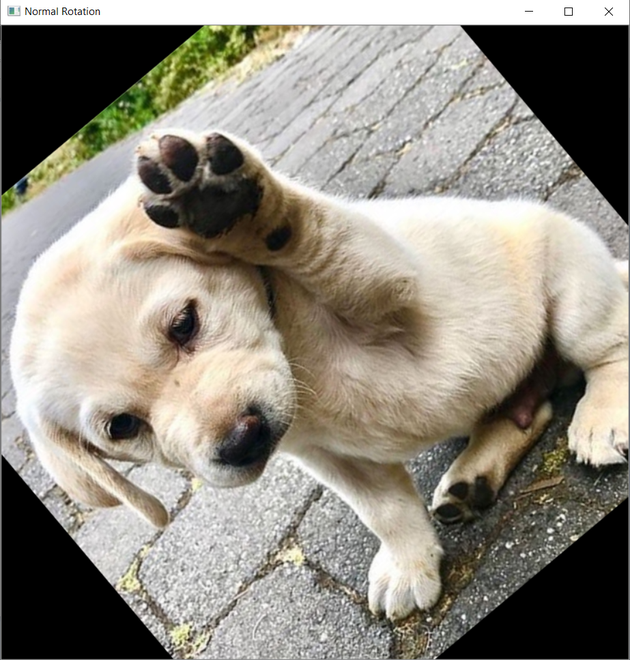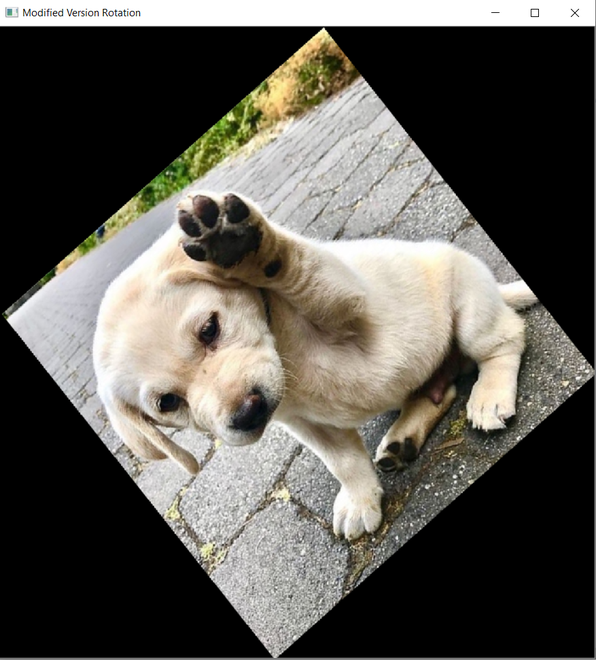Requisito previo : procesamiento de imágenes en Python (escalado, rotación, desplazamiento y detección de bordes)
Rotar imágenes con OpenCV es fácil, pero a veces las tareas de rotación simples recortan/cortan los lados de una imagen, lo que lleva a una imagen a la mitad. Ahora, en este tutorial, exploraremos una solución para rotar una imagen de manera segura sin recortar/cortar los lados de una imagen para que toda la imagen se incluya en la rotación, y también compararemos el método de rotación convencional con la versión de rotación modificada.
Enfoque paso a paso:
- Para rotar una imagen sin cortar los lados, crearemos una función explícita llamada ModifedWay() que tomará la imagen en sí y el ángulo al que se rotará la imagen como argumento.
- En la función, primero, obtenga la altura y el ancho de la imagen.
- Localiza el centro de la imagen.
- Luego calcule la array de rotación 2D
- Extraiga los valores absolutos de seno y coseno de la array de rotación.
- Obtenga la nueva altura y anchura de la imagen y actualice los valores de la array de rotación para asegurarse de que no haya recortes.
- Finalmente, use el método wrapAffine() para realizar la rotación real de la imagen.
A continuación se muestra la implementación del enfoque:
Python3
def ModifiedWay(rotateImage, angle): # Taking image height and width imgHeight, imgWidth = rotateImage.shape[0], rotateImage.shape[1] # Computing the centre x,y coordinates # of an image centreY, centreX = imgHeight//2, imgWidth//2 # Computing 2D rotation Matrix to rotate an image rotationMatrix = cv2.getRotationMatrix2D((centreY, centreX), angle, 1.0) # Now will take out sin and cos values from rotationMatrix # Also used numpy absolute function to make positive value cosofRotationMatrix = np.abs(rotationMatrix[0][0]) sinofRotationMatrix = np.abs(rotationMatrix[0][1]) # Now will compute new height & width of # an image so that we can use it in # warpAffine function to prevent cropping of image sides newImageHeight = int((imgHeight * sinofRotationMatrix) + (imgWidth * cosofRotationMatrix)) newImageWidth = int((imgHeight * cosofRotationMatrix) + (imgWidth * sinofRotationMatrix)) # After computing the new height & width of an image # we also need to update the values of rotation matrix rotationMatrix[0][2] += (newImageWidth/2) - centreX rotationMatrix[1][2] += (newImageHeight/2) - centreY # Now, we will perform actual image rotation rotatingimage = cv2.warpAffine( rotateImage, rotationMatrix, (newImageWidth, newImageHeight)) return rotatingimage
A continuación se muestran algunos ejemplos que muestran cómo rotar una imagen sin cortar los lados usando la función anterior:
Ejemplo 1:
A continuación se muestra la implementación de la versión de rotación modificada junto con su comparación con la versión de rotación normal:
Python3
# Importing Required Libraries
import cv2
import numpy as np
# The below function is for conventionally way of rotating
# an Image without preventing cutting off sides
def SimpleWay(rotateImage, angle):
# Taking image height and width
imgHeight, imgWidth = rotateImage.shape[0], rotateImage.shape[1]
# Computing the centre x,y coordinates
# of an image
centreY, centreX = imgHeight//2, imgWidth//2
# Computing 2D rotation Matrix to rotate an image
rotationMatrix = cv2.getRotationMatrix2D((centreY, centreX), angle, 1.0)
# Now, we will perform actual image rotation
rotatingimage = cv2.warpAffine(
rotateImage, rotationMatrix, (imgWidth, imgHeight))
return rotatingimage
# The Below function is a modified version of the
# conventional way to rotate an image without
# cropping/cutting sides.
def ModifiedWay(rotateImage, angle):
# Taking image height and width
imgHeight, imgWidth = rotateImage.shape[0], rotateImage.shape[1]
# Computing the centre x,y coordinates
# of an image
centreY, centreX = imgHeight//2, imgWidth//2
# Computing 2D rotation Matrix to rotate an image
rotationMatrix = cv2.getRotationMatrix2D((centreY, centreX), angle, 1.0)
# Now will take out sin and cos values from rotationMatrix
# Also used numpy absolute function to make positive value
cosofRotationMatrix = np.abs(rotationMatrix[0][0])
sinofRotationMatrix = np.abs(rotationMatrix[0][1])
# Now will compute new height & width of
# an image so that we can use it in
# warpAffine function to prevent cropping of image sides
newImageHeight = int((imgHeight * sinofRotationMatrix) +
(imgWidth * cosofRotationMatrix))
newImageWidth = int((imgHeight * cosofRotationMatrix) +
(imgWidth * sinofRotationMatrix))
# After computing the new height & width of an image
# we also need to update the values of rotation matrix
rotationMatrix[0][2] += (newImageWidth/2) - centreX
rotationMatrix[1][2] += (newImageHeight/2) - centreY
# Now, we will perform actual image rotation
rotatingimage = cv2.warpAffine(
rotateImage, rotationMatrix, (newImageWidth, newImageHeight))
return rotatingimage
# Driver Code
# Loading an Image from Disk
DogImage = cv2.imread("doggy.png", 1)
# Performing 40 degree rotation
NormalRotation = SimpleWay(DogImage, 40)
ModifiedVersionRotation = ModifiedWay(DogImage, 40)
# Display image on Screen
cv2.imshow("Original Image", DogImage)
# Display rotated image on Screen
cv2.imshow("Normal Rotation", NormalRotation)
cv2.imshow("Modified Version Rotation", ModifiedVersionRotation)
# To hold the GUI screen and control until it is detected
# the input for closing it, Once it is closed
# control will be released
cv2.waitKey(0)
# To destroy and remove all created GUI windows from
#screen and memory
cv2.destroyAllWindows()
Producción:

Imagen original

Rotación normal con función SimpleWay()

Rotación con la función ModifiedWay()
Ejemplo 2:
Aquí hay otro ejemplo que representa el método de rotación moderno:
Python3
# Importing Required Libraries
import cv2
import numpy as np
# The Below function is a modified version of the
# conventional way to rotate an image without
# cropping/cutting sides.
def ModifiedWay(rotateImage, angle):
# Taking image height and width
imgHeight, imgWidth = rotateImage.shape[0], rotateImage.shape[1]
# Computing the centre x,y coordinates
# of an image
centreY, centreX = imgHeight//2, imgWidth//2
# Computing 2D rotation Matrix to rotate an image
rotationMatrix = cv2.getRotationMatrix2D((centreY, centreX), angle, 1.0)
# Now will take out sin and cos values from rotationMatrix
# Also used numpy absolute function to make positive value
cosofRotationMatrix = np.abs(rotationMatrix[0][0])
sinofRotationMatrix = np.abs(rotationMatrix[0][1])
# Now will compute new height & width of
# an image so that we can use it in
# warpAffine function to prevent cropping of image sides
newImageHeight = int((imgHeight * sinofRotationMatrix) +
(imgWidth * cosofRotationMatrix))
newImageWidth = int((imgHeight * cosofRotationMatrix) +
(imgWidth * sinofRotationMatrix))
# After computing the new height & width of an image
# we also need to update the values of rotation matrix
rotationMatrix[0][2] += (newImageWidth/2) - centreX
rotationMatrix[1][2] += (newImageHeight/2) - centreY
# Now, we will perform actual image rotation
rotatingimage = cv2.warpAffine(
rotateImage, rotationMatrix, (newImageWidth, newImageHeight))
return rotatingimage
# Driver Code
# Loading an Image from Disk
Image = cv2.imread("gfg.png", 1)
# Performing 40 degree rotation
ModifiedVersionRotation = ModifiedWay(Image, 40)
# Display image on Screen
cv2.imshow("Original Image", Image)
# Display rotated image on Screen
cv2.imshow("Modified Version Rotation", ModifiedVersionRotation)
# To hold the GUI screen and control until it is detected
# the input for closing it, Once it is closed
# control will be released
cv2.waitKey(0)
# To destroy and remove all created GUI windows from
#screen and memory
cv2.destroyAllWindows()
Producción:


Publicación traducida automáticamente
Artículo escrito por himanshukanojiya y traducido por Barcelona Geeks. The original can be accessed here. Licence: CCBY-SA